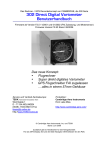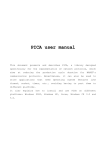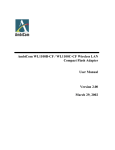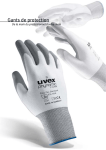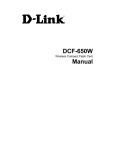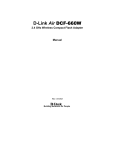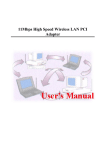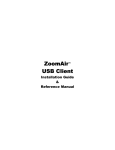Download Socket Mobile 11Mbps Network Card User Manual
Transcript
11Mbps Wireless LAN CF Card PDF created with FinePrint pdfFactory Pro trial version http://www.fineprint.com Date of Issue: January. 25th, 2002 PDF created with FinePrint pdfFactory Pro trial version http://www.fineprint.com Technical Support The firmware and driver version of the Wireless LAN CF Card is displayed on the utility About tab. Users could download and upgrade the latest software version from the supplier’s web site or refer to the sales contact for the latest software information. If you have difficulty resolving the problem while installing or using the Wireless LAN CF Card, please contact the supplier for support. About This Manual 11Mbps Wireless LAN CF Card User Manual is first published on January, 2002. The manual includes procedures for the setup of the 11Mbps Wireless LAN CF Card under Windows CE 3.0, Pocket PC 2002, Windows XP, Windows 2000, Windows 98, Windows ME and Windows NT. Take a moment to read through this manual and familiarize yourself with wireless technology. Software Information The software package works only on the Wireless LAN CF Card and Wireless LAN PCMCIA Card, and contains the following versions of driver and utility programs. For CE Windows System: Ø Driver -- Version 1.1.0 and above Ø Utility -- Version 1.1.0 and above For Windows XP/2000/NT/98/ME Systems: Ø Driver -- Version 4.0.7 Ø Utility -- Version 4.0.7 PDF created with FinePrint pdfFactory Pro trial version http://www.fineprint.com FCC Information This device complies with Part 15 of the FCC Rules. Operation is subject to the following two conditions: (1) this device may not cause harmful interference, and (2) this device must accept any interference received; including interference that may cause undesired operation. Federal Communications Commission (FCC) Statement This Equipment has been tested and found to comply with the limits for a Class B digital device, pursuant to Part 15 of the FCC rules. These limits are designed to provide reasonable protection against harmful interference in a residential installation. This equipment generates, uses and can radiate radio frequency energy and, if not installed and used in accordance with the instructions, may cause harmful interference to radio communications. However, there is no guarantee that interference will not occur in a particular installation. If this equipment does cause harmful interference to radio or television reception, which can be determined by turning the equipment off and on, the user is encouraged to try to correct the interference by one or more of the following measures: - Reorient or relocate the receiving antenna. - Increase the separation between the equipment and receiver. - Connect the equipment into an outlet on a circuit different from that to which the receiver is connected. -Consult the dealer or an experienced radio/TV technician for help. FCC RF Radiation Exposure Statement: 1. This Transmitter must not be co-located or operating in conjunction with any other antenna or transmitter. 2. This equipment complies with FCC RF radiation exposure limits set forth for an uncontrolled environment. This equipment should be installed and operated with a minimum distance of 20 centimeters between the radiator and your body. PDF created with FinePrint pdfFactory Pro trial version http://www.fineprint.com Table of Contents Chapter 1 About Wireless LAN CF Card ............................................ 1 1-1 Features and Benefits................................................................................ 1 1-2 Applications .............................................................................................. 2 1-3 Product Kit................................................................................................ 3 1-4 LED Information ....................................................................................... 3 Chapter 2 Install the CF Card for Pocket PC 2002/Win CE3.0 .......... 4 2-1 System Requirements................................................................................. 4 2-2 Before Getting Started............................................................................... 4 2-3 Install the Setup Utility ............................................................................. 7 2-4 Install the Wireless LAN CF Card............................................................. 9 Chapter 3 Set the CF Card under Pocket PC 2002/WinCE3.0 ......... 10 3-1 Using Wireless LAN Utility Under Pocket/Handheld PC........................ 10 Chapter 4 Install the CF Card for Windows XP/2000/NT/98/ME ... 18 4-1 System Requirements............................................................................... 18 4-2 Insert the Wireless LAN CF Card ........................................................... 18 4-3 Set up Wireless LAN CF Card for Windows XP ...................................... 19 4-4 Set up Wireless LAN CF Card for Windows 2000 ................................... 24 4-5 Set up Wireless LAN CF Card for Windows NT 4.0 ................................ 27 4-6 Set up Wireless LAN CF Card for Windows 98/ME ................................ 30 4-7 Remove the Wireless LAN PC Card ........................................................ 33 Chapter 5 Set the CF Card under Windows XP/2000/NT/98/ME... 35 5-1 Install the WLAN Utility.......................................................................... 35 5-2 Using the WLAN Utility........................................................................... 37 Limited Warranty ................................................................................. 47 PDF created with FinePrint pdfFactory Pro trial version http://www.fineprint.com About Wireless LAN CF Card 1 The 11Mbps IEEE 802.11b Wireless LAN CF Card is a standard CF typeⅡ interface adapter integrated with wireless LAN technology. It provides you the easiest and fastest way to access your wireless and wired network. The Wireless LAN CF Card, which utilizes the latest advancement of PC industry – Compact Flash technology, allows you to install and use the card easier than ever before. 11Mbps data rate gives equivalent Ethernet speed to access corporate network or the Internet in a wireless environment. When installed, 11Mbps Wireless LAN CF Card is able to communicate with any 802.11 and 802.11b compliant products. 1-1 Features and Benefits 1. Fully IEEE 802.11b compatible. 2. Direct Sequence Spread Spectrum (DSSS) technology provides robust, interference-resistant and secure wireless connection. 3. Supports 1, 2, 5.5 and 11 Mbps data rate. 4. Working range up to 800 ft. in an open environment. 5. Seamless connectivity to wired Ethernet and PC network LAN’s augments existing networks quickly and easily. 6. Greater flexibility to locate or move networked PCs. 7. Wireless connection without the cost of cabling. 8. Easy to install and user friendly, just Plug and Play. 9. Low power consumption. 10. Supports a variety of operating systems (Pocket PC 2002, WinCE/Win98/ME/NT/2000/XP) 11. 64-bit and 128-bits WEP encryption capable. 12. Provides Window-based Diagnostic Tools, most notably, Site Survey, Link Quality Test and Access Point Browser. -1- PDF created with FinePrint pdfFactory Pro trial version http://www.fineprint.com 1-2 Applications 11Mbps Wireless LAN CF Card offers a fast, reliable and cost-effective solution for wireless client access to the network in applications like these: 1. Remote access to corporate network information E-mail, file transferring and terminal emulation. 2. Difficult-to-wire environments Historical or old buildings, asbestos installations, and open area where wiring is difficult to deploy. 3. Frequently changing environments Retailers, manufacturers and those who frequently relocate the workplace. 4. Temporary LANs for special projects or peak time C1. Trade shows, exhibitions and construction sites where a temporary network will be practical. C2. Retailers, airline and shipping companies need additional workstations during peak period. C3. Auditors requiring workgroups at customer sites. 5. Access to database for mobile workers Doctors, nurses, retailers, accessing their database while being mobile in the hospital, retail store or office campus. 6. SOHO (Small Office and Home Office) users SOHO users who need easy and quick installation of a small computer network. 7. High security connection The secure wireless network can be installed quickly and provide flexibility. (Please refer to page 14 (under Windows CE) and 40 (under Windows XP/2000/98/ME/NT) for encryption configuration.) -2- PDF created with FinePrint pdfFactory Pro trial version http://www.fineprint.com 1-3 Product Kit 11Mbps Wireless LAN CF Card comes with the following items. Please go through each item below. If any listed item is not included or found damaged, please contact your local dealer. 11Mbps Wireless LAN CF Card l l 11Mbps Wireless LAN CF Card… … … … … … … .… … … … … … … … .… .… .. x 1 Wireless LAN CF Card Product CD … … … … … … … ..… … … … … … … … .... x 1 l 11Mbps Wireless LAN CF Card QIG… … … .… … … … ..… … … … … … … ..… x1 l CF/PCMCIA Adapter (Optional)… … … … … … … … … … … … … … … … … .… x1 1-4 LED Information The 11Mbps Wireless LAN CF Card has one LED indicator. described as below: Link LED n n The behavior of the indicator is LINK Solid Green – Associated with the Access Point or Ad-Hoc wireless workstation. Blinking Green – Not connecting to the Access Point or Power Save mode enabled. -3- PDF created with FinePrint pdfFactory Pro trial version http://www.fineprint.com Install the CF Card for Pocket PC 2002/WinCE 3.0 2 This chapter describes the instructions that guide you through the proper hardware installation of your 11Mbps Wireless LAN CF Card for Pocket PC 2002 and Windows CE 3.0 operating system. 2-1 System Requirements In order to use the 11Mbps Wireless LAN CF Card, your computer must be equipped with the following: Pocket PC (PPC) n Compaq: IPAQ (CPU: Strong ARM) Jonada 525 and 548 (CPU: SH3) n HP: All models (MIPS R4000) n Casio: ..... Handheld PC (HPC) ■ Sharp: Telios (MIPS R3000) ■ HP: Jornada 720 (Strong ARM) ■ Intel: Pentium/X86 CPU More to come, check with supplier’s website. 2-2 Before Getting Started Before installing the driver and utility of the Wireless LAN CF Card for the Pocket PC/Handheld PC, you need to first establish a connection between host PC and PDA device with Microsoft Active Sync. Instructions are as follows: -4- PDF created with FinePrint pdfFactory Pro trial version http://www.fineprint.com Step 1: Install the Microsoft Active Sync program that came with your PDA Product CD. Follow the on-screen instructions to install the Active Sync on the host computer. Step 2: Upon completion of installation, establish an ActiveSync connection between the host computer and the Pocket PC using a serial cable, a USB cable, or an infrared link. (Refer to your Pocket PC manual for instructions. A “Get Connected “ message will pop-up. Click Next to proceed. -5- PDF created with FinePrint pdfFactory Pro trial version http://www.fineprint.com Step 3: The ActiveSync will start looking for your Pocket PC/Handheld PC to get connected. Step 4: Once the connection has been made, you will see the “connected” message shown as below figure. -6- PDF created with FinePrint pdfFactory Pro trial version http://www.fineprint.com 2-3 Install the Setup Utility Step 1: After successfully forming a connection between host PC and PDA device with ActiveSync Program, insert the CD-ROM into the CD-ROM drive and run the setup utility (nb825.exe) for Windows CE operating system. The InstallShield Wizard will launch automatically. Click Next to continue. Step 2: An InstallShield Wizard window appears. Click Next to proceed. -7- PDF created with FinePrint pdfFactory Pro trial version http://www.fineprint.com Step 3: Click YES when prompted to install the Compact Flash Card driver and utility in the default application install directory. Step 4: Follow on-screen instructions to install the Setup Utility. Click Finish to complete the installation. -8- PDF created with FinePrint pdfFactory Pro trial version http://www.fineprint.com 2-4 Install the Wireless LAN CF Card Step 1: Insert the 11Mbps Wireless LAN CF Card into the CF slot on your PDA. The PDA will auto-detect the Wireless LAN CF Card and automatically install the corresponding driver and utility. Step 2: Assign an IP address to your Wireless LAN CF Card. You may either set the Wireless LAN CF Card to obtain an IP address from your DHCP server, or to be assigned with a fixed IP address. Step 3: Reset your PDA. Upon completion of installation, the Wireless LAN CF Card will start to look for an Access Point with Green LED blinking. The Green LED will stay steady once the Wireless LAN CF Card successfully associates with an Access Point. please proceed to the next chapter. To configure the Wireless LAN CF Card -9- PDF created with FinePrint pdfFactory Pro trial version http://www.fineprint.com Set the CF Card under Pocket PC 2002/Win CE3.0 3 This chapter gives you assistance with detailed description of setting the 11Mbps Wireless LAN CF Card with the Wireless LAN Utility under Pocket/Handheld PC. 3-1 Using Wireless LAN Utility Under Pocket/Handheld PC The 11Mbps Wireless LAN CF Card is a ready-to-use device. Its default settings perform for a typical Infrastructure Wireless LAN. Simply install the Wireless LAN CF Card onto your computer and it is ready to use. In special situations however, you may adjust configuration settings depending on how you would like to manage your wireless network. The Wireless LAN Utility provides you an easy interface to make configuration changes and perform user-level diagnostics on your Wireless LAN CF Card. Step 1: Go to Start --> Settings. Go to the System tab, and click the “Wireless LAN Setting” icon. -10- PDF created with FinePrint pdfFactory Pro trial version http://www.fineprint.com A configuration window appears. The Wireless LAN Utility provides the 5 following items for you to configure and monitor the 11Mbps Wireless LAN CF Card. Status The Status tab displays the current status of the Wireless LAN CF Card. Adapter - Displays the name of the Wireless LAN CF Card. Firmware - Displays the firmware version of your Wireless LAN CF Card. Domain - The regulated operating frequency per country. Channel - Displays the current channel that the Wireless LAN CF Card is using. MAC Address - It is a hardware identification number that distinguishes the unit from others. Sync to AP - Displays the ESSID of the Access Point that the Wireless LAN CF Card associates with. BSSID - Shows MAC Address of the Access Point that the Wireless LAN CF Card associates with. Link Quality - Link quality monitors the quality of the data transmission between the Wireless LAN CF Card and an Access Point. Signal Level - This bar graph displays signal strength as reported by the radio, averaged over all frames that are received from the Access Point. -11- PDF created with FinePrint pdfFactory Pro trial version http://www.fineprint.com Configuration The Configuration tab contains several fields where the current parameters of the Wireless LAN CF Card can be viewed and changed. You will see current configuration information in terms of ESSID, Network Type, Power Saving Mode and Tx Rate. Upon modification of parameters for the Wireless LAN CF Card, click the Apply button to make the changes take effect. ESSID The ESSID is an unique ID given to the Access Point. Wireless clients associating to Access Points must have the same ESSID. The default value Auto Detect means when the Wireless LAN CF Card starts to work, it will associate with any Access Point that gives the fastest response. You may also enter a specific ESSID (Access Point) you desire to connect with. It is recommended that you specify an ESSID for your Wireless LAN CF Card. This will prevent your computer from unintentionally connecting to a different wireless network. The ESSID can be set up to 32 characters and is case sensitive. Network Type There are 3 network types for the 11Mbps Wireless LAN PC Card to operate. If you need to access company network or Internet via Access Point, select “Infrastructure”. To set up a group of wireless stations for file and printer sharing, select “Ad-Hoc” or “802.11 Ad-Hoc” (without Access Point). If Ad-Hoc (without access point) is selected, you need to set wireless stations with the same channel. For 802.11 Ad-Hoc, the same ESSID are required to the wireless stations. -12- PDF created with FinePrint pdfFactory Pro trial version http://www.fineprint.com Power Saving Mode The Power Saving Mode option is designed to conserve battery life of you computer. When the Power Saving Mode is activated by selecting the Enable button, your 11Mbps Wireless LAN CF Card will go into sleep mode to minimize power consumption. Note: When power saving mode is enabled, the Access Points you use need to support power saving as well so that the communication can be established. TX Rate The 11Mbps Wireless LAN CF Card provides various data rate options for you to select. Data rates options include Auto, 1Mbps, 2Mbps, 1M/2Mbps, 5.5Mbps, and 11Mbps. In most networking scenarios, you will see that the factory-set default “Auto” will prove the most efficient. This setting will allow your 11Mbps Wireless LAN CF Card to operate at the maximum data rate. When the communications quality drops below a certain level, the Wireless LAN CF Card will automatically switch to a lower data rate. Transmission at lower data speed is usually more reliable. However, when the communications quality improves again, the Wireless LAN CF Card will gradually increase the data rate again, until it has reached the highest available transmit rate. Link Similar to Ping Command, this tool allows you to point-to-point data transmission quality between two stations. By entering IP address of another station and set the timeout and packet size, you may check whether the communication has been made successfully or not. -13- PDF created with FinePrint pdfFactory Pro trial version http://www.fineprint.com Security To prevent unauthorized wireless stations from accessing data transmitted over the network, the 11Mbps Wireless LAN CF Card offers highly secure data encryption, known as WEP (Wired Equivalent Privacy). If you desire to use WEP encryption to secure your data, please select the Enable check box and set the following values. Ø There are two types of WEP Key Length described as follows: 40 Bit – Requires wireless stations to use data encryption with 40 Bit algorithm when communicating with the Access Point also with WEP 40 enabled. 128 Bit – Allows wireless clients to communicate with the Access Point with data 128 Bit encryption algorithm. -14- PDF created with FinePrint pdfFactory Pro trial version http://www.fineprint.com Ø WEP Key Type offers two methods to set the WEP keys, as described below: Create Encryption Keys by Using a Passphrase Step 1. To create encryption keys by using a passphrase, pull down the WEP Key Type and select Passphrase. Step 2. Type a character string in the Key in the phrase to generate keys field, then click OK. As you type, the utility uses an algorithm to generate 4 keys automatically. -15- PDF created with FinePrint pdfFactory Pro trial version http://www.fineprint.com Step 3. Select one key from the 4 WEP keys and click Apply button to make the setting take effect. Create Encryption Keys Manually You can also create encryption keys manually by choosing the Char or Hex. For 40-bit encryption: ■ 5 characters in the range of “A-Z”, “a-z” and “0-9” (e.g. MyKey, shown as above figure). ■ 10 digit hexadecimal values in the range of “A-F”, “a-f” and “0-9” (e.g. 11AA22BB33). For 128-bit encryption: n 13 characters in the range of “A-Z”, “a-z” and “0-9” (e.g. MyKey12345678) n 26 digit hexadecimal values in the range of “A-F”, “a-f” and “0-9” (e.g. 12345678901234567890123456) Select one key from the 4 WEP keys and the Apply button to make the setting take effect. Moreover, you may choose the Authentication Type, either Open System or Shared Key for authentication among wireless devices. The Open System and Shared Key are the identification methods defined in the IEEE802.11 standard. The difference is that the Shared Key requires the use of the WEP privacy mechanism for authentication. Simply put, if the Shared Key is selected, you need to set the WEP Keys. -16- PDF created with FinePrint pdfFactory Pro trial version http://www.fineprint.com About The About tab shows driver and utility version of the Wireless LAN CF Card. -17- PDF created with FinePrint pdfFactory Pro trial version http://www.fineprint.com Install the CF Card for Windows XP/2000/NT/98/ME 4 This section describes the installation of the 11Mbps Wireless LAN CF Card driver for the Windows XP/2000/NT/98/ME operating systems. The installation procedures for Windows XP refer to 4-3 Set up Wireless LAN CF Card for Windows XP; for Windows 2000 please see 4-4 Set up Wireless LAN CF Card for Windows 2000; for Windows NT please go to 4-5 Set up Wireless LAN CF Card for Windows NT; for Windows 98/ME refer to 4-6 Set up Wireless LAN CF Card for Windows 98/ME. Note: Before you start the installation, you are advised to keep the Windows CD-ROM in case you might need certain system files. 4-1 System Requirements In order to use the 11Mbps Wireless LAN CF Card, your computer must be equipped with the following: 1. A PCMCIA Type II slot, and a PCMCIA card and socket services compliant with revision 2.10 of the PCMCIA specification (or higher). 2. Windows 98/ME/NT/2000/XP (with a Windows installation CD-ROM, diskettes for use during installation) 3. Minimum 500 Kbytes free disk space for installing driver and utility program. 4-2 Insert the Wireless LAN CF Card Step 1: If your PC has a compact flash type II slot, simply insert the Wireless LAN CF Card into the CF slot. If not, use the CF/PCMCIA Adapter as stated in the next procedure. Step 2: Firmly insert the 11Mbps Wireless LAN CF Card into the CF/PCMCIA Adapter, figured as below. Then insert the 11Mbps Wireless LAN CF Card into the PCMCIA slot of your computer. -18- PDF created with FinePrint pdfFactory Pro trial version http://www.fineprint.com CF/PCMCIA Adapter CF Card CAUTION: Do not force the client adapter into the slot. Forcing it will damage both the client adapter and the slot. If the client adapter does not go in easily, remove the card and reinsert it. The Wireless LAN CF Card only supports 3.3v. Make sure your laptop PC supports 3.3v, otherwise, it might cause damage to the device. 4-3 Set up Wireless LAN CF Card for Windows XP Step 1: After inserting the Wireless LAN CF Card into the PC, the Windows will auto-detect the Wireless LAN PC Card and a “Found New Hardware Wizard” window will show up. Select “Install from a list or specific location (Advanced)” to install the driver. -19- PDF created with FinePrint pdfFactory Pro trial version http://www.fineprint.com Step 2: Insert the Product CD-ROM into the CD-ROM drive. Check the “Search removable media (floppy, CD-ROM… )” check box and click on Next to install the driver. Step 3: The windows will find “IEEE 802.11 Wireless LAN/CF Card (3V)” and start copying corresponding files into the system. Click on Next to continue. -20- PDF created with FinePrint pdfFactory Pro trial version http://www.fineprint.com Step 4: Click Finish to complete the software installation. Step 5: Right click “My Computer” from Start, select Properties, go to the Hardware tab and click the Device Manager button to see if any error icon appears next to the Network adapters/IEEE 802.11 Wireless LAN/CF Card (3V). If no, your 11Mbps Wireless LAN PC Card is working well. Check if there is any error icon next to the IEEE 802.11 Wireless LAN CF Card -21- PDF created with FinePrint pdfFactory Pro trial version http://www.fineprint.com After installing the 11Mbps Wireless LAN CF Card, the Windows XP will display a “Wireless Network Connection # ” message. Click on the message and the “Automatic Wireless Network Configuration will then appear automatically and allow use to choose to connect a wireless infrastructure network (Access Point), shown as the below figure. You may click the Advanced button to make advanced configuration for the Wireless LAN CF Card, shown as below. -22- PDF created with FinePrint pdfFactory Pro trial version http://www.fineprint.com For more information on using the automatic wireless network configuration please refer to Windows XP Help file. If you desire to use our WLAN Utility, you need to disable the Windows XP Automatic Wireless Network Configuration first by un-checking this check box. However, the WLAN Utility, which comes with the Wireless LAN CF Card provides you more tools to configure the CF Card and monitor the wireless connection. For more information on installing and using the WLAN utility please refer to the following sections “Installation of the WLAN Utility” and “Usage of the WLAN Utility”. Note: To use the WLAN utility under Windows XP, you need to disable the Automatic Wireless Network Configuration first. Steps are described as follows: n Right click the Network Connections icon. Select Properties. n Go to the Wireless Networks tab. Uncheck the “Use Windows to configure my wireless network settings” check box and click the OK button (see the above picture). -23- PDF created with FinePrint pdfFactory Pro trial version http://www.fineprint.com 4-4 Set up Wireless LAN CF Card for Windows 2000 Step 1: After inserting the Wireless LAN CF Card into the PC, the Windows 2000 will automatically detect the 11Mbps Wireless LAN CF Card. Step 2: A “Found New Hardware Wizard” window shows up. Click Next to proceed. -24- PDF created with FinePrint pdfFactory Pro trial version http://www.fineprint.com Step 3: Select “Search for a suitable driver for my device [recommended]” and click Next. Step 4: Insert the Product CD-ROM into the CD-ROM drive. Specify the location where the driver is placed, then click Next. -25- PDF created with FinePrint pdfFactory Pro trial version http://www.fineprint.com Step 5: The windows will find “_IEEE_802.11_Wireless_LAN/CF_Card”. Click on Next to continue. Step 6: Click Finish to complete the software installation. -26- PDF created with FinePrint pdfFactory Pro trial version http://www.fineprint.com Step 7: Open Control Panel/System/Device Manager, and check Network Adapters to see if any error icon appears. If no, your 11Mbps Wireless LAN CF Card is working well. Check if there is any error icon next to the IEEE 802.11 Wireless LAN CF Card 4-5 Set up Wireless LAN CF Card for Windows NT 4.0 Step 1: From the desktop, select Control Panel, double-click Network, go to the Adapters tab, and then click the Add button. -27- PDF created with FinePrint pdfFactory Pro trial version http://www.fineprint.com Step 2: Windows NT will present a list of all its supported adapters. Windows NT will present a list of all its supported adapters. Click Have Disk to continue. Step 3: Windows NT will ask for the path containing the 11Mbps Wireless LAN PC Card driver for Windows NT. Insert the Product CD-ROM into the CD-ROM drive, and then click OK to continue. -28- PDF created with FinePrint pdfFactory Pro trial version http://www.fineprint.com Step 4: The Windows will find “IEEE 802.11 Wireless LAN/CF Card”. Click OK and Windows will then copy the necessary files into the system. Step 5: Restart the Windows to finish the installation. Step 6: To ensure whether the 11Mbps Wireless LAN PC Card works fine or not, go to Control Panel, double-click Devices, then verify whether the 11Mbps PC Card driver has started. Check whether the driver is successfully installed and started -29- PDF created with FinePrint pdfFactory Pro trial version http://www.fineprint.com 4-6 Set up Wireless LAN CF Card for Windows 98/ME Step 1: After inserting the 11Mbps Wireless LAN PC Card into the PCMCIA slot on your notebook, Windows will auto-detect new hardware and will display an “Add New Hardware Wizard” window. Click Next to continue. Step 2: Select “Search for the best driver for your device (Recommended)” and click Next. -30- PDF created with FinePrint pdfFactory Pro trial version http://www.fineprint.com Step 3: Insert the Product CD-ROM into the CD-ROM drive. Select the “CD-ROM drive” check box and click on Next to install the driver. Step 4: The Windows will find “IEEE 802.11 Wireless LAN/CF Card(3V)”. Click Next to continue. -31- PDF created with FinePrint pdfFactory Pro trial version http://www.fineprint.com Step 5: Once the [Please insert the disk labeled ‘Windows 98 Second Edition CD-ROM/ME CD-ROM”, and then click OK] window appears, inset enter the path corresponding to the appropriate drives and click OK. Usually these files can be found at C:Windows or C:Windows\system. Step 6: Click Finish to complete the software installation. Step 7: Restart the computer. -32- PDF created with FinePrint pdfFactory Pro trial version http://www.fineprint.com Step 8: Open Control Panel/System/Device Manager, and check Network Adapters to see if any error icon appears next to the IEEE 802.11 Wireless LAN CF Card. Wireless LAN PC Card is working well. If no, your 11Mbps Check if there is any error icon next to the 11Mbps Wireless LAN CF Card 4-7 Remove the Wireless LAN PC Card If you do not need the wireless connectivity of your 11Mbps Wireless LAN CF Card, it is advised that you remove the card from its slot as described below: Note: When removing the 11Mbps Wireless LAN PC Card, you will lose your connection to the network. Prior to removing the PC Card, make sure you have closed all files and network applications (such as e-mail). -33- PDF created with FinePrint pdfFactory Pro trial version http://www.fineprint.com You are advised to always disable the Wireless LAN CF Card prior to removing the card from the PC Card slot. This will allow the Windows operating system to: n Log off from the network server. n Disable the 11Mbps Wireless LAN PC Card driver. n Disconnect power to the PC Card slot (which will extend battery life for mobile computers) To stop using the 11Mbps Wireless LAN CF Card, do the following steps: 1. Click once on the PC Card icon on the right side of the Windows task bar. 2. Select the option “Stop IEEE 802.11 Wireless LAN/CF Card (3V)”. 3. Wait a few seconds until the operating system displays a pop-up message to indicate you can safely remove the Wireless LAN CF Card. Click OK and you may then take out the 11Mbps Wireless LAN CF Card. -34- PDF created with FinePrint pdfFactory Pro trial version http://www.fineprint.com Set the CF Card under Pocket PC 2002/WinCE 3.0 5 This chapter gives you assistance with detailed configuration for the 11Mbps Wireless LAN CF Card under Windows XP/2000/NT/98/ME. 5-1 Install the WLAN Utility To install the WLAN Utility, follow these steps: Step 1: Insert the Product CD-ROM or floppy disk again. Step 2: Go to the utility folder and run setup.exe. Step 3: The InstallShield Wizard will show up and guide you through the rest of the setup process. Run the Setup Utility Choose Destination Location and click Next to continue. -35- PDF created with FinePrint pdfFactory Pro trial version http://www.fineprint.com Select a program folder and click Next. You may add a shortcut in the startup folder as desired. Upon completion, go to Program Files and run the WLAN Utility and its icon will appear in the System Tray in the bottom right corner of your task bar. Clicking on the icon will open the configuration window. When you minimize the window, the system tray icon will be loaded in the System Tray again. The color behind the system tray icon indicates the link status: Blue indicates a good or excellent link. Yellow indicates a usable but weak link. Red indicates no or very poor link quality. When you minimize the window, the system tray icon will be loaded in the System Tray again. -36- PDF created with FinePrint pdfFactory Pro trial version http://www.fineprint.com 5-2 Using the WLAN Utility The WLAN Utility enables you to make configuration changes and perform user-level diagnostics on your 11Mbps Wireless LAN CF Card in the Windows XP/2000/NT/98/ME operating system environments. The WLAN Utility consists of window with 5 items for you to monitor and configure the 11Mbps Wireless LAN CF Card: Configuration, Link Test, AP Browser, Site Survey and About. Configuration: The Configuration item allows you to modify the configuration parameters for the 11Mbps Wireless LAN CF Card such as Profile, Network Type, Ad-Hoc Channel, Transmit Rate, ESSID, WEP, RTS/CTS, Fragment Threshold, and Power Save mode. Furthermore, you may monitor the current status of the Wireless CF Card such as State, Current Channel, Current Tx Rate, Throughput, Link Quality and Signal Strength. -37- PDF created with FinePrint pdfFactory Pro trial version http://www.fineprint.com Profile The Profile field allows you to set values for all parameters by selecting a previously defined profile. To create the profile, go to the Profile field, type a profile name and set the corresponding parameters. If one of the profiles is no longer used, you may remove it by clicking the Delete button. After changing parameters, save the profile and click the Apply button to take effect. You can have multiple profiles and modify the profile at any time. Alternatively, you may choose the profile by right clicking the system tray icon on the task bar, making the configuration more friendly and efficient. You may right click the WLAN system tray icon to choose the pre-set profiles Network Type There are 3 network types for the 11Mbps Wireless LAN CF Card to operate. If you need to access company network or Internet via Access Point, select “Infrastructure”. To set up a group of wireless stations for file and printer sharing, select “Pseudo AdHoc” or “802.11 AdHoc” (without Access Point). If Pseudo Ad-Hoc (without access point) is selected, you need to set wireless stations with the same channel. For 802.11 AdHoc, the same ESS ID is required to the wireless stations. -38- PDF created with FinePrint pdfFactory Pro trial version http://www.fineprint.com ESSID The ESS ID is the unique ID used by Access Points and stations to identify a wireless LAN. Wireless clients associating to any Access Point must have the same ESSID. The default setting is ANY, which allows your Wireless LAN PC Card to automatically associate to any Access Point (Infrastructure mode) in the vicinity of your wireless adapter. Alternatively, you may check the ESS ID check box to specify the ESS ID. It will then attempt to associate with Access Points or stations with the same ESS ID. The ESS ID can be set up to 32 characters and is case sensitive. Check here before entering the ESS ID If there two Access Points with the same ESSID, you may check the BSS ID check box and enter the MAC address of the Access Point you desire to connect to. Check here before entering the BSS ID Transmit Rate The 11Mbps Wireless LAN CF Card provides various data rate options for you to select. Data rates options include Fully Auto, 2 Mb, Auto 1 or 2 Mb, 5.5 Mb, and 11 Mb. In most networking scenarios, you will see that the factory-set default “Fully Auto” will prove the most efficient. This setting will allow your 11Mbps Wireless LAN CF Card to operate at the maximum data rate. When the communications quality drops below a certain level, the CF Card will automatically switch to a lower data rate. Transmission at lower data speeds are usually more reliable. However, when the communications quality improves again, the 11Mbps Wireless LAN CF Card will gradually increase the data rate again, until it has reached the highest available transmit rate. -39- PDF created with FinePrint pdfFactory Pro trial version http://www.fineprint.com WEP To prevent unauthorized wireless stations from accessing data transmitted over the network, the WLAN Utility offers highly secure data encryption, known as WEP, making your data transmission over air more secure. To activate the WEP Encryption, check the WEP Enabled check box. An Encryption window will then appear. The instructions are as follows: Ø Pull down the Encryption (WEP) menu and select either 64bit or 128bit encryption method. Ø Specify the encryption keys. There are two methods to set the WEP keys, as described below: Create Encryption Keys by Using a Passphrase To create encryption keys by using a passphrase, click the Create Key with Passphrase check box and type a character string in the Passphrase field. As you type, the utility uses an algorithm to generate 4 keys automatically. Select either the 64bit or 128bit encryption first, and type a string in the Create Key with Passphrase field. Select one key from the 4 WEP keys and click OK. Then click the Apply button on the Configuration tab to make the setting take effect. Create Encryption Keys Using a Passphrase (128bit) -40- PDF created with FinePrint pdfFactory Pro trial version http://www.fineprint.com Create Encryption Keys Manually You can also create encryption keys manually by clicking the Create Keys Manually check box. For 64bit encryption you may choose: n Alphanumeric: 5 characters (case sensitive) ranging from “a-z”, “A-Z” and “0-9” (e.g. MyKey) n Hexadecimal: 10 hexadecimal digits in the range of “A-F”, “a-f” and “0-9” (e.g. 11AA22BB33) For 128bit encryption you may choose: n Alphanumeric: 13 characters (case sensitive) ranging from “a-z”, “A-Z” and “0-9” (e.g. MyKey12345678) n Hexadecimal: 26 hexadecimal digits in the range of “A-F”, “a-f” and “0-9” (e.g. 00112233445566778899AABBCC). After entering the WEP keys in the key field, select one key as active key, click the OK button and then click the Apply button on the Configuration tab to make the setting take effect. Create Encryption Keys Manually (64bit) Note: The WEP key must be set up exactly the same on the Wireless LAN stations as they are on the wireless Access Points. If you set “MyKey” for the Wireless LAN CF Card, the same WEP Key “MyKey” must be assigned to the Access Point or other stations. -41- PDF created with FinePrint pdfFactory Pro trial version http://www.fineprint.com Advance The WLAN Utility also offers the advanced configuration for user to set the 11Mbps Wireless LAN CF Card under certain network environment. These advanced options include Power Management, RTS/CTS and Fragmentation Threshold. To enable the advanced configuration, go to the Configuration tab and click the Advance button. Power Management The Power Save option is designed to conserve battery life of you computer. When Power Save is enabled, your 11Mbps Wireless LAN CF Card will go into sleep mode to minimize power consumption. Note: When power saving mode is enabled, the Access Points you use need to support power saving as well so that the communication can be established. RTS Threshold RTS Threshold is a mechanism implemented to prevent the “Hidden Node” problem. “Hidden Node” is a situation in which two stations are within range of the same Access Point, but are not within range of each other. The following figure illustrates an example of the “Hidden Node” problem. Both stations (STA) are within range of the Access Point, however, they cannot hear each other. Therefore, they are hidden nodes for each other. When a station starts data transmission with the Access Point, it might not notice that the other station is already using the wireless medium. When these two stations send data at the same time, they might collide when arriving simultaneously at the Access Point. The collision will most certainly result in a loss of messages for both stations. -42- PDF created with FinePrint pdfFactory Pro trial version http://www.fineprint.com Thus, the RTS Threshold mechanism provides a solution to prevent data collisions. When you enable RTS Threshold on a suspect “hidden station”, this station and its Access Point will use a Request to Send/Clear to Send protocol (RTS/CTS). The station will send an RTS to the Access Point, informing that it is going to transmit the data. Upon receipt, the Access Point will respond with a CTS message to all station within its range to notify all other stations to defer transmission. It will also confirm the requestor station that the Access Point has reserved it for the time-frame of the requested transmission. If the “Hidden Node” problem is an issue, please specify the packet size. The RTS mechanism will be activated if the data size exceeds the value you set. It is highly recommended that you set the value ranging from 0 to 1500. The default value is Disable. Note: Enabling RTS Threshold would cause redundant network overhead that could negatively affect the throughput performance instead of providing a remedy. Frag. Threshold Fragmentation mechanism is used for improving the efficiency when high traffic flows along in the wireless network. If your 11Mbps Wireless LAN CF Card often transmit large files in wireless network, you can enable the Fragmentation Threshold by clicking the Enable button and the mechanism will split the packet. The value can be set from 256 to 1500. default value is Disable. The IRQ NO./IO Address To avoid device conflict, you may modify the IRQ No. and IO Address for your device (Only available under Windows NT). -43- PDF created with FinePrint pdfFactory Pro trial version http://www.fineprint.com Status: The Status field on the Configuration menu provides the following information. State: When operating in Infrastructure mode, this field shows the MAC address of the Access Point with which the Wireless LAN CF Card is communicating. When operating in Ad-Hoc mode, it shows the virtual MAC address used by computers participating in the Ad-Hoc network. Current Channel: Shows the channel on which the connection is made. Current Tx Rate: Shows the highest transmit rate of the current association. Throughput: Shows the short term transmit and receive throughput in bytes/second, and is continuously updated. Link Quality: Based on the quality of the received signal of the Access Point beacon. 5 states of link quality: There are 100%~80%: Excellent link. 80%~60%: Good link quality. 60%~40%: Fair link quality. Under 40%: Poor or no connection. Signal Strength: Based on the received signal strength measurement of the baseband processor of the Beacon signal. Same as link quality, there are 5 states of signal strength: 100%~80%: Excellent signal strength. 80%~60%: Good signal strength. 60%~40%: Fair signal strength. Under 40%: Poor or no signal strength. You can click the Rescan button to force the radio to rescan all available channels. If your link quality or signal strength is poor, rescanning can be used to push the radio off a weak Access Point and search for a better link with another Access Point. -44- PDF created with FinePrint pdfFactory Pro trial version http://www.fineprint.com Link Test: The Link Test tool helps you examine data transmission quality between your 11Mbps Wireless LAN CF Card and any workstation on the network. By entering IP address of 2 remote station, setting ping interval and packet size, you may know whether communication has been made successfully or not. Additionally, you may run the loopback test (proprietary) by clicking the Loop back button to verify the communication quality between your wireless station and Access Point. The Refresh button is used for setting the counters back to 0. AP Browser: By clicking the Rescan button, the AP Browser can display Access Points around the working environment. Besides showing the ESSID of each Access Point, it also displays BSSID, Channel, Signal, Quality and Supported Rates. To join any of the displayed Access Points, highlight the Access Point you desire to connect and then click the Join BSS (when there are more than 2 Access Points with the same ESSID), or Join ESS button to join the group. -45- PDF created with FinePrint pdfFactory Pro trial version http://www.fineprint.com Site Survey: When the Site Survey screen is displayed, the channel quality of all 14 radio channels will be displayed. These channel quality measurements are shown on each gauge for the 14 radio channels. The blue bar indicated the channel quality is clear and good. The higher the blue bar is, the better quality you have (i.e., less interference). The yellow bar indicates the channel quality is fair and the red bar indicates the channel is busy or having severe interference. About: The About item shows the versions of the Wireless LAN Utility, driver, firmware of the 11Mbps Wireless LAN CF Card. Also, the MAC address and frequency domain are displayed. -46- PDF created with FinePrint pdfFactory Pro trial version http://www.fineprint.com Limited Warranty This Warranty constitutes the sole and exclusive remedy of any buyer or reseller’s equipment and the sole and exclusive liability of the supplier in connection with the products and is in lieu of all other warranties, express, implied or statutory, including, but not limited to, any implied warranty of merchantability of fitness for a particular use and all other obligations or liabilities of the supplier. In no even will the supplier or any other party or person be liable to your or anyone else for any damages, including lost profits, lost savings or other incidental or consequential damages, or inability to use the software provided on the software media even if the supplier or the other party person has been advised of the possibility of such damages. The following are special terms applicable to your hardware warranty as well as services you may use during part of the warranty period. Your formal Warranty Statement, including the warranty applicable to our Wireless LAN products, appears in the Quick Installation Guide which accompanies your products. Duration of Hardware Warranty: One Year Replacement, Repair or Refund Procedure for Hardware: If your unit needs a repair or replacement, return it to your dealer/distributor in its original packaging. When returning a defective product for Warranty, always include the following documents: n n n The Warranty Repair Card A copy of the invoice/proof of purchase, and The RMA Report Form (To receive a Return Materials Authorization form (RMA), please contact the party from whom you purchased the product). Upon proof-of-purchase we shall, at its option, repair or replace the defective item at no cost to the buyer. This warranty is contingent upon proper use in the application for which the products are intended and does not cover products which have been modified without the reseller’s approval or which have been subjected to unusual physical or electrical demands or damaged in any way. -47- PDF created with FinePrint pdfFactory Pro trial version http://www.fineprint.com Please complete the information below and include it along with your products. Name: Title: Company: Telephone: Fax: Email: City/State/Zipcode: Country: Product Name: Serial Number: MAC Address: Invoice Date: Product Description: If you have any further questions, please contact your local authorized reseller for support. -48- PDF created with FinePrint pdfFactory Pro trial version http://www.fineprint.com





















































